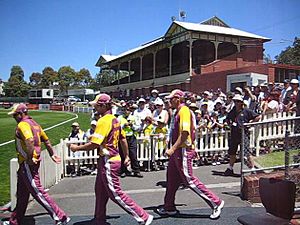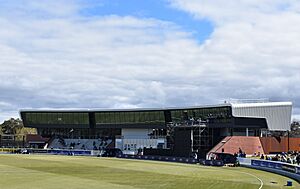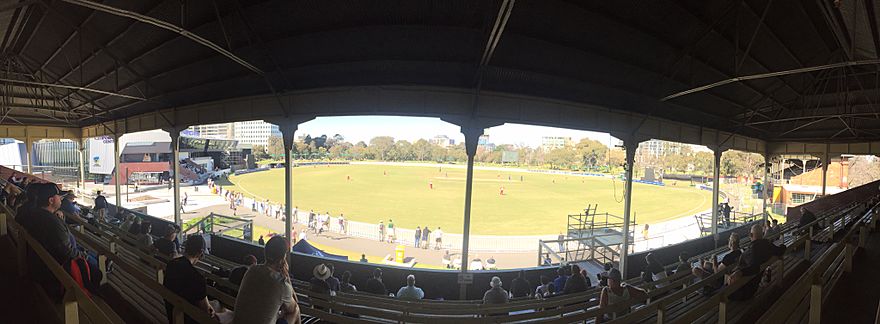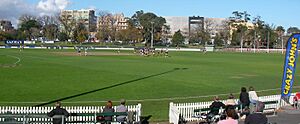Junction Oval facts for kids
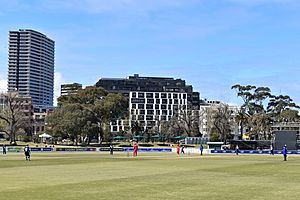
Victoria v South Australia cricket teams match at
the Junction Oval, September 2018 |
|
| Location | St Kilda, Victoria |
|---|---|
| Coordinates | 37°51′21″S 144°58′48″E / 37.85583°S 144.98000°E |
| Owner | Victoria State Government |
| Operator | Cricket Victoria |
| Capacity | 7,000 |
| Record attendance | 46,973 (VFL game, 20 May 1950) |
| Surface | Grass (Oval) |
| Construction | |
| Opened | 1856 |
| Renovated | 2015–18 |
| Construction cost | $40 million (2015–18 redevelopment) |
| Tenants | |
Victoria cricket team (2018–present)
St Kilda/University Football Club (Challenge Cup; 1875) South Melbourne Football Club (VFL; 1944–1946) Fitzroy Football Club (VFL; 1970–1984) |
|
| Ground information | |
| Tenants | Victoria cricket team |
| International information | |
| First women's Test | 21 February 1958: |
| Last women's Test | 5 February 1972: |
| First WODI | 9 February 2000: |
| Last WODI | 14 January 2025: |
| First WT20I | 22 January 2013: |
| Last WT20I | 2 March 2020: |
| As of 14 January 2025 Source: Cricinfo |
|
The Junction Oval is a famous sports ground in St Kilda, Victoria, a suburb of Melbourne, Australia. It is also known as the St Kilda Cricket Ground. Sometimes, it's called the CitiPower Centre because of a company sponsorship.
This oval gets its name from being close to the St Kilda Junction. It's about five kilometers south of Melbourne's city center. It sits in the southern part of the big Albert Park sports area. The Junction Oval is now the main office for Cricket Victoria. It was updated between 2015 and 2018 to serve this important role.
Contents
A Look at Junction Oval's History
The St Kilda Cricket Ground started in 1856. The first big seating area, called a grandstand, was put up in 1892. A new grandstand was built in 1925–26. It cost £7000 and was designed by E J Clark. This stand was later named the Shane Warne stand in 2024.
Another brick stand was built in 1933–34. It cost £7500 and was named after cricketers Don Blackie and Bert Ironmonger. Both of these old grandstands are still used today. A new scoreboard was added in 1956–57. This was for the cricket club's 100th birthday. The scoreboard is a well-known sight in the St Kilda Junction area.
The rest of the ground has grassy banks. The Junction Oval is a very pretty place. It has a great playing field and modern buildings around it. Today, about 7,000 people can watch games there.
Shane Warne's Connection to the Oval
Famous cricketer Shane Warne had a long history with the St Kilda Cricket Ground. He played his first big game for Victoria here in 1991. He also played many times for his club, St Kilda, between 1989 and 2006. In 2013, Warne helped support keeping the ground ready for important cricket matches.
Modern Upgrades for Cricket Victoria
In December 2014, the Victoria State Government said it would give $25 million to update the Oval. This was to make it the main office and training center for Cricket Victoria. By the end of 2015, Cricket Victoria and Cricket Australia added another $15 million. This allowed the upgrades to go ahead.
The new venue has many cool features. It has a national center for cricket training. There is also on-site housing for visiting teams. It includes medical and training areas. There is a large outdoor training field and a 10-lane indoor center. The main offices for Cricket Victoria are also there.
These upgrades made the oval a great place for important cricket games. It can hold up to 7,000 fans. The new ground was first used for a Sheffield Shield match on March 3, 2018. The Melbourne Stars played their first men's Big Bash League game here on January 2, 2022.
Cricket at Junction Oval
Junction Oval started with the St Kilda Cricket Club in 1856. This club has played its home games here ever since. They play in the Victorian Premier Cricket competition. Before the upgrades from 2015–2018, the oval hosted 28 important cricket matches. This included 25 Sheffield Shield games.
Victoria needed another good cricket ground. The Melbourne Cricket Ground (MCG) holds 100,000 people, which is very big. Sometimes, the state team had to play important finals in other states. The upgrades helped solve this problem. Now, Victoria can host matches at a suitable venue. This also helps the MCG.
The oval can now host Women's Big Bash League matches. It is also the main office for Cricket Victoria. The venue is often called the CitiPower Centre. The Victorian team used the oval in 2005–06. This was when the MCG was getting ready for the 2006 Commonwealth Games.
The Junction Oval became a full-time cricket venue in 2015. This was part of its big upgrade. Now, the Victorian state team plays many home games here. They play in the One-Day Cup and Sheffield Shield competitions. The Victorians quickly found success at the new ground. They won their sixth One-Day Cup and 32nd Sheffield Shield here in the 2018–19 season.
Australian Rules Football History
The Junction Oval has a long history with Australian rules football. This ended with the upgrades in 2015.
The very first football match with official league status was played here on May 28, 1870. The St Kilda Football Club played its home games here from 1874. They continued to play here until 1964. There were breaks during World War I and World War II.
Other clubs also used the oval as their home ground. These included South Melbourne from 1944–1946. The Fitzroy Football Club played here from 1970–1984. The first ever women's football match was also played at the oval in 1921.
The St Kilda Football Club played 564 home games here between 1897 and 1964. Their last home game was on August 22, 1964. They won against Geelong in front of 37,100 fans. After 1964, St Kilda moved to Moorabbin Oval.
The Fitzroy Football Club moved to the oval in 1970. They stayed until the end of 1984. Fitzroy played 135 home games here. They were asked to leave the venue in 1984. They then moved their home games to Victoria Park.
The last VFL game at Junction Oval was on September 1, 1984. Fitzroy played St Kilda in front of 15,156 people. Fitzroy won that game.
The ground also hosted six VFL finals matches. This included three Grand Finals in 1898, 1899, and 1944. Fitzroy won all three of these Grand Finals. Between 1870 and 1984, 845 top-level football matches were played at the ground.
The Melbourne Football Club used the oval for training from 1985 to 2010. The last football team to use the oval was the Old Melburnians Football Club. They played their final game there on July 22, 2015.
Highest Attendance Records
The most people ever at the Junction Oval was 46,973. This was on May 20, 1950. Fans came to watch St Kilda play Carlton in a VFL match. This crowd was even bigger than for any of the Grand Finals held there.
For a South Melbourne home game, the record was 38,000 fans. They watched South Melbourne play Richmond in 1946.
Fitzroy's biggest home game crowd was 27,202. This was against Collingwood in 1981.
Other Sports and Events
Junction Oval has hosted more than just cricket and football. On March 3, 1975, famous boxer "Smokin" Joe Frazier fought Jimmy Ellis here. Frazier won the fight.
Other big events included Victorian athletics titles in 1898/99. There were also many bicycle races. Two international lacrosse matches between Victoria and New South Wales were also held here. In 1978, a rugby league trial match was played. It was between Western Suburbs and Manly Warringah. This game started a famous rivalry between the two teams.


